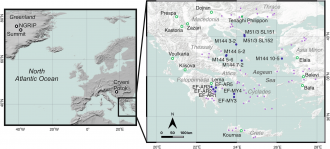Media release
From:
Ancient Greek and Roman cultures caused lead pollution in Aegean Sea region
Lead pollution in the Aegean Sea region may have begun around 5,200 years ago, according to a paper published in Communications Earth & Environment. The findings suggest that lead pollution due to human activities began approximately 1,200 years earlier than previously thought, and that the expansion of the Roman Empire across the Aegean region led to a significant increase in lead pollution in the region around 2,150 years ago.
Andreas Koutsodendris and colleagues analysed the lead content of marine sediment cores taken from across the Aegean Sea and a sediment core taken from the Tenaghi Philippon peatland, located in northeastern Greece. They then analysed the pollen and spore content of several of the cores, combining this with similar existing data for the region and the lead content data, to investigate how the region’s ecosystems were affected by the social and cultural changes at the time.
The findings include the earliest recorded signal of probable human-caused lead pollution, occurring around 5,200 years ago in the Tenaghi Philippon core. This is approximately 1,200 years earlier than the previous earliest suspected lead pollution, recorded in cores from peatlands in the Balkan Peninsula. The authors also suggest that a change in the vegetation record and an increase in the lead pollution signal around 2,150 years ago are likely linked to the expansion of the Roman Empire into Ancient Greece at that time. This period was marked by a significant increase in the mining of gold, silver, and other metals for use in currency and other items. The increase in the lead pollution signal includes the first presence of lead in marine sediment cores, which the authors suggest is the earliest recorded probable lead pollution in a marine environment.
Multimedia




 International
International



